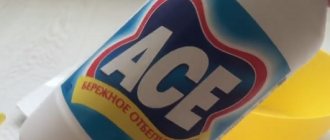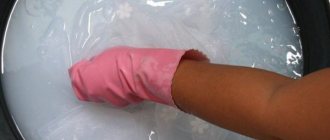No matter how the fashion for window decoration changes, white tulle remains an unchanged classic. Transparent snow-white curtains will add lightness and airiness to any interior and will be an ideal solution for a living room, bedroom, kitchen or nursery. But, unfortunately, such curtains do not retain their original luster for long. Due to dust, bright sun, radiators, and the touch of hands, the tulle loses its snow-white color, and the room no longer looks fresh and clean.
Unfortunately, regular washing does not return the whiteness of nylon tulle fabric, but only gets rid of dirt. Every housewife sooner or later wonders how to bleach tulle at home and return it to its original appearance without spoiling the material. In fact, there are many options for solving the tulle problem. I know how to wash and bleach tulle using very simple and affordable means and get rid of the smell. Among them there are both time-tested “grandmother’s” methods of whitening and modern means.
Causes of pollution
The appearance of the product deteriorates under the influence of certain factors.
- Dust and dirt - dust particles in the apartment, exhaust gases and sand from the street - all this settles on the window drapery and gives it a gray tint.
- The sun - due to active rays, the canvas acquires a yellow tint.
- Touching and other human factors - when we pull back the curtain, we leave a trace on it, albeit invisible to the naked eye. Gradually, an unsightly stain forms in this place. In the kitchen, drops of fat are added to this. The situation is even more complicated in a house where there are children: there is a possibility that paints, felt-tip pens, plasticine and other difficult-to-remove contaminants will get on the canvas.
How to bleach tulle at home, according to reviews from housewives
It’s good that there are responsible housewives who shared their feedback on the tulle bleaching process!
Review of the use of oxygen bleach "Persol" Greenfield Rus:
More details on Otzovik:
Economix bleach review:
More details on Otzovik:
Frau Schmidt bleach review:
More details on Otzovik:
Another review of Frau Schmidt bleach:
More details on Otzovik:
Taking care of the beauty and cleanliness of curtains will give your home comfort and freshness! And if you have your own recommendations, share them with our readers.
There are no publications on the topic.
Selecting a method
The bleaching technology depends on the fabric from which the tulle is made. Any of its types - organza, veil, muslin, muslin - can be made from different materials, and the washing method depends on this. Obviously, cotton curtains will withstand a much more aggressive procedure than silk ones.
In order not to spoil the thing, you will have to select a method, also focusing on the structure of the tulle material.
- Organza and veil do not tolerate friction or hot baths. They need to be lightened with salt, blue or brilliant green.
- Nylon products are also difficult to maintain and can withstand temperatures of no more than 30 degrees Celsius. Salt, starch, laundry soap, brilliant green and blue are suitable for them.
- Chiffon has a weightless translucent structure and therefore requires gentle handling. Saline solution and laundry soap will do.
- Linen will be washed correctly with ammonia.
- Cotton will withstand any test, including boiling with laundry soap.
Ammonia and hydrogen peroxide
If a beautiful nylon curtain has turned grey, you can use a mixture of ammonia and hydrogen peroxide - they will return the tulle to its appearance:
- Fast method. Add 2 tbsp to warm water (+50 °C) with a volume of 5–6 liters. spoons of hydrogen peroxide and 1 tbsp. a spoonful of ammonia. Immerse the fabric in the solution for half an hour and then rinse thoroughly. After this, do not wring out the tulle, but immediately hang it to dry.
- The second method takes longer. Dissolve a bottle of ammonia in water. Immerse the tulle in the resulting liquid overnight. In the morning, rinse the fabric thoroughly and hang it up.
- Add 20 ml of peroxide to the washing powder. Set your washing machine to a delicate cycle. Hang the washed tulle to dry.
Useful tips
There are several recommendations that it is advisable to find out before the procedure. Following them will help you achieve good results.
- It is advisable to shake off the dust from the tulle. It's better to do this outside. If you put the curtain to be washed directly, a large amount of dust will be absorbed into the structure of the fabric.
- Before bleaching, it is correct to wash the accessory by hand or in a machine (depending on the material). Bleaching cannot replace washing, and if it is neglected, the result will not be very good.
- Washing should be done on a delicate cycle without spinning. Otherwise, wrinkled tulle will be difficult to iron out. The drying sequence should be as follows: hang the washed curtains so that the liquid drains from them, and when the dripping stops, you can return them to the curtain rod, where they constantly hang. All folds will straighten out under their own weight.
- By the way, in order for the material to wrinkle less, it must be carefully folded before loading it into the drum. This will help avoid unpleasant creases that form due to careless handling.
- Water for treatment should have a temperature of no more than 30 degrees. If you soak it in hot water, the yellowness will penetrate even deeper into the thread.
Do I need to rub, twist, iron?
Before making the tulle snow-white, you need to prepare for this process according to all the rules:
- shake out the cloth to remove dust;
- stop using chlorine-containing products;
- temperature for washing tulle - no higher than 40°C (hot water will ruin the fabric, and cold water will not cope with dirt);
- the best detergent for washing is liquid;
- if you use powder, it must first be dissolved;
- the fabric does not need to be rubbed;
- so that the curtains are without folds, they are not twisted;
- do not dry the tulle in the sun - you will get a yellow color;
- To iron the tulle after washing, you don’t need to take an iron: you just need to hang wet curtains on the curtain rod.
If you are washing curtains simply as a refreshing preventative, use salt. The classic way to wash tulle so that it turns white: make salt water with the addition of powder and leave the curtain in this solution. In the morning, wash and rinse - the fabric will become snow-white. By the way, if the curtains are multi-colored, then washing the tulle with salt will add richness to the colors.
Whitening methods
When choosing an option on how to make a curtain snow-white, you can go in two ways: trust “grandmother’s” recipes or buy a special product. Both options are not without their drawbacks.
Folk recipes are often too universal and do not take into account the material from which the textiles are made. In addition, you may stumble upon an incorrect recipe that contains incorrect proportions or the wrong holding time. It is possible that during the implementation process the hostess will confuse or forget something. Then you either won’t achieve results or ruin the product.
Among the advantages of such methods, it is worth noting the cheapness of the ingredients and the fact that most of them are found in every home. Also, these substances almost never cause allergies, and therefore can be used even for children.
Purchased products are captivating with their ease of use and effectiveness: most often they can be added directly at the time of washing, and you do not have to waste time and effort on additional soaking.
And the result is quite impressive: the tulle sparkles with whiteness, as if it had just come from the store.
But the active elements of these products are aggressive: they penetrate the fiber and destroy it. Therefore, do not be surprised if after three or four procedures the textile turns into a mesh that breaks at any touch.
Ammonia and hydrogen peroxide
This recipe is not suitable for products made of synthetic fiber, but is one of the most effective for returning white color to natural fabrics.
You need to heat 5 liters of water to 60 degrees, dissolve 1 tablespoon of ammonia and 2 tablespoons of 3% peroxide. You need to put the tulle there for 15–20 minutes, rinse and hang to dry.
Don't forget to wear gloves to protect your hands!
Salt
The safest and gentlest method. Although it must be said that it is not advisable to use it for severe pollution.
To prepare, you need to stir half a glass of washing powder and 6 tbsp into 10 liters of hot water. l. non-iodized coarse salt.
The curtains are placed in a basin with the composition for 8–12 hours, after which they must be washed in the usual way and dried.
Zelenka
Zelenka is also a “safe” technique, and therefore can be used for any type of fabric. The solution is prepared as follows:
- Add 7-10 drops of the product into a glass of water, stir thoroughly and leave for a couple of minutes;
- if you see sediment in the glass, stir again and strain;
- Pour the liquid into a container with warm water (10 l).
Pre-washed tulle should be placed in a basin with this solution and, turning over, rinsed for 3-4 minutes. All that remains is to dry the textiles.
You can use a slightly different procedure with brilliant green.
Blue
It has been used by housewives for quite a long time and gives the canvas a slightly noticeable bluish tint, hiding grayness and yellowness. This substance can be used to prepare a solution and for washing in a washing machine.
- Solution
Half a teaspoon of the product must be diluted in 10 liters of water. Rinse the item in this liquid for several minutes, then rinse and hang to dry.
- Machine washable
Place 1 tsp in the conditioner compartment. blue and turn on a double rinse at the end. In this case, the rest should be done as usual: curtains - into the drum, powder - into a special compartment.
The use of cleaners that have a pigment (blue, brilliant green, potassium permanganate) requires special care when diluting. If undissolved crystals remain, colored stains will appear on the fabric, which cannot be removed.
Laundry soap
An unattractive bar of soap is a universal lifesaver from many misfortunes. These include yellowing of the material.
- For delicate items
Grate the soap on a coarse grater. You will need one glass of chips. It needs to be poured into boiling water (3-4 l) and dissolved. This mixture must be combined with cold water. The result is 7-8 liters of warm liquid.
It is advisable to soak the curtain for at least 12 hours. Be sure to rinse thoroughly afterwards.
Another option for processing “capricious” curtains involves adding potassium permanganate. Add 100 g of grated soap to 1 liter of water. In another vessel, combine a pinch of potassium permanganate and 200 ml of water. All crystals should dissolve. Both mixtures should be poured into a basin with 6-7 liters of water and stirred. Immerse the tulle in a pale pink soapy mixture for half an hour, and then wash.
- For cotton
Boiling is only suitable for durable textiles that have turned yellow or have persistent stains.
You need to boil 7 liters of water, add a glass of grated soap and stir. The fabric is immersed in a vat and boiled with occasional stirring for 1 hour. Then the material needs to be dipped in cold water and rinsed.
Starch
Starch not only helps restore whiteness, but also gives the product texture and forms beautiful folds. In addition, a thin layer is formed on the surface of the thread, which repels dust and protects from the sun.
- You should combine one glass of starch and water. In this case, be sure to break up all the lumps, and if this does not work, then it is better to strain the mixture.
- Pour the mixture into a bowl of warm water (5-6 l) and place the tulle there.
- After 6 hours, the canvas needs to be removed and carefully hung.
Special means
When you go to the store, your eyes run wide from the huge amount of cleaning products. They come in the form of gels, powders, and soaps. However, if you look at it, based on the principle of action, bleaches are divided into three main types.
- Oxygen
The main component of such compositions is sodium percarbonate, which, when exposed to a humid environment, turns into soda and hydrogen peroxide. The first component softens hard water, and the second releases active oxygen, which triggers an oxidation reaction on tissue. This is what gets rid of stains and odors.
You will have to take into account that such products are most active in hot water (80–90 degrees), and it is strictly contraindicated for most materials from which curtains are sewn.
If you have a bottle of oxygen purifier sitting idle for a long time, then do not expect it to be effective: within 3-6 months from the date of manufacture, oxygen becomes 75% less active.
- Chlorine-containing
The active element is sodium hypochlorite. It is very aggressive and penetrates deep into the thread, “etching out” dirt, yellowness and grayness. In addition, chlorine chemicals disinfect and are inexpensive.
However, despite all the positive aspects, such substances have more disadvantages.
Firstly , chlorine destroys fabric fiber and leads to its thinning, so with regular use the fabric becomes loose and breaks easily.
In the “life” of tulle there should be no more than one or two treatments with a chlorine preparation.
Secondly , such compositions are strictly contraindicated for synthetic products. They are only applicable to cotton and linen.
Thirdly , during work, a pungent odor is felt, which is not only unpleasant, but in high concentrations is also harmful to health.
Fourthly , chemical residues are difficult to rinse out, and therefore often cause allergies.
Fifthly , chlorine activity decreases by 50–75% within 9 months from the date of production. Therefore, monitor deadlines carefully.
- Optical
In fact, they do not get rid of grayness and yellowness, but only mask it, creating the illusion of purity. The luminescent particles included in the composition are fixed on the surface of the thread at the time of washing and make it glow from the inside.
The dosage must be strictly observed, otherwise there is a possibility that the matter will acquire a greenish or bluish tint.
It is also noted that the effectiveness of such chemicals is not very high. If the dirt is strong or there are stains, then optical brightener cannot cope with it.
Green paint for whiteness
There is another folk remedy that allows you to find out how to bleach tulle. We are talking about using brilliant green:
- You need to dilute 10 drops of brilliant green in 200 ml of water (in pharmacies the drug is called brilliant green). To enhance the effect, many housewives add another 2 tbsp. spoons of regular table salt. It should be thoroughly mixed in the solution. Otherwise, streaks will remain on the fabric. After this, dilute the concentrate in water.
- Dip pre-washed tulle into the resulting solution for 5 minutes, turning it over periodically. Once the curtain is pulled out, it is not unscrewed. After the water has drained, hang the product flat and allow it to dry completely.
We recommend reading: What to do if there is a rotten smell from the washing machine
This way you can whiten tulle in just a few minutes.
The only disadvantage of the method is the risk of greenish stains appearing on the curtain if a sediment remains in the solution due to carelessness. Getting rid of these stains will be problematic.
The advantages include the same savings and availability of funds. In addition, bleaching with brilliant green occurs much faster than with salt.
Bleaching very dirty old tulle
If for some reason you do not want to get rid of a product that has lost its beauty, then you can try a set of measures to resuscitate cotton fabric at home, using the methods described above.
- First boil the curtain.
- Then use the method with ammonia and peroxide.
- Next step: soaking in saline solution.
- Finally, starch the fabric.
For synthetic materials, a more delicate technology is suitable.
- Use soaking with laundry soap.
- Next, it is better to resort to saline solution.
- Treat with brilliant green.
- And just like in the previous version - rinse with starch.
If these measures did not help, then it should be recognized that this curtain has already outlived its usefulness and you will have to either come to terms with its shortcomings or go for a new one.
Starch as a bleach
The tulle must be washed first. If there is no heavy contamination, you can clean it from dust. Dilute 200–300 grams of starch per 10 liters of water. Immerse the tulle fabric in the resulting solution. It needs to be soaked in liquid for 5–6 hours.
After this time, hang the curtains straight to dry. Don't squeeze them out.
Like other “grandmother’s” methods, this method is very simple and most accessible to every housewife. It is worth noting that starch helps give the tulle a certain shape, and also forms a film on the surface of the product that repels dirt and dust.











